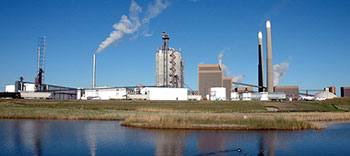 European mega-financier, Fortis, has inked a deal to buy 1.1 million megawatt hours of power for the next 10 years from Enel North America. The estimated $80-million deal is seen as a hedge against the price of electricity from natural gas.
European mega-financier, Fortis, has inked a deal to buy 1.1 million megawatt hours of power for the next 10 years from Enel North America. The estimated $80-million deal is seen as a hedge against the price of electricity from natural gas.
This article posted on the CNNMoney.com web site says the power will come the the Snyder Wind Farm in Texas, 63-megawatt project consisting of 21 wind turbines:
Based on an industry estimate of $50 to $80 per megawatt hour, the transaction carries a price of up to $80 million, marking the latest in a big boom in wind projects around the country.
“Wind energy is a rapidly growing generation resource for the U.S. and we’ll continue to pursue hedging transactions not only in renewable power, but in conventional power as well,” said David Duran, managing director at Fortis Merchant & Private Banking, a unit of the Brussels-based financial conglomerate.
Fortis will market the wind-power hedge to financial players, hedge funds, power companies and other energy-investment market participants.
The article goes on to say that the American Wind Energy Association estimates that installation and production of wind generators is up about 25 percent this year alone.


 A biodiesel plant that will add 30 percent to the U.S. biodiesel production capacity when it opens will start doing just that when the Imperium Renewables plant at Gray’s Harbor in Washington state starts production on Wednesday.
A biodiesel plant that will add 30 percent to the U.S. biodiesel production capacity when it opens will start doing just that when the Imperium Renewables plant at Gray’s Harbor in Washington state starts production on Wednesday. Congressman Tim Mahoney is the honorary summit chair and the
Congressman Tim Mahoney is the honorary summit chair and the 
 Unique to the U.S. ethanol industry, Blue Flint Ethanol is located adjacent to Coal Creek Station, a coal-fired electric facility, and is using the excess steam from Coal Creek to run its ethanol production operations.
Unique to the U.S. ethanol industry, Blue Flint Ethanol is located adjacent to Coal Creek Station, a coal-fired electric facility, and is using the excess steam from Coal Creek to run its ethanol production operations.
 “SunEthanol has unique technology that if proven to be commercially feasible will be a positive step forward for cellulosic ethanol.” said Bill Honnef, VeraSun Senior Vice President, Sales and Marketing. “While we believe corn-based ethanol production will continue to play a key role in our industry long into the future, ethanol from cellulosic feedstocks will complement corn-based ethanol in meeting the growing global demand for renewable fuels. We continue to evaluate technologies that have the potential to efficiently convert cellulose to biofuels.”
“SunEthanol has unique technology that if proven to be commercially feasible will be a positive step forward for cellulosic ethanol.” said Bill Honnef, VeraSun Senior Vice President, Sales and Marketing. “While we believe corn-based ethanol production will continue to play a key role in our industry long into the future, ethanol from cellulosic feedstocks will complement corn-based ethanol in meeting the growing global demand for renewable fuels. We continue to evaluate technologies that have the potential to efficiently convert cellulose to biofuels.” Ty Adams, a 28-year-old freelance journalist and green RV activist from Bozeman, Mont., has spent the past nine months on the road. He’s hit 24 states and put 18,000 miles on his multicolored Monaco, also known as the bioTrekker.
Ty Adams, a 28-year-old freelance journalist and green RV activist from Bozeman, Mont., has spent the past nine months on the road. He’s hit 24 states and put 18,000 miles on his multicolored Monaco, also known as the bioTrekker. Price’s initiative impressed Tim Waters, a WSU extension educator based in Pasco. He and another professor for WSU’s crop and soil sciences program began working with Price and helping where they could.
Price’s initiative impressed Tim Waters, a WSU extension educator based in Pasco. He and another professor for WSU’s crop and soil sciences program began working with Price and helping where they could.
 General Motors, Governor Chet Culver and Kum & Go, L.C. today celebrated plans for the addition of 19 new E85 ethanol fueling locations to be opened throughout the state by the end of 2008. The new fueling locations will be promoted by GM as part of a broader, ongoing national GM campaign to boost the use and awareness of ethanol-based E85 fuel in the United States.
General Motors, Governor Chet Culver and Kum & Go, L.C. today celebrated plans for the addition of 19 new E85 ethanol fueling locations to be opened throughout the state by the end of 2008. The new fueling locations will be promoted by GM as part of a broader, ongoing national GM campaign to boost the use and awareness of ethanol-based E85 fuel in the United States. According to a
According to a  Researchers at
Researchers at